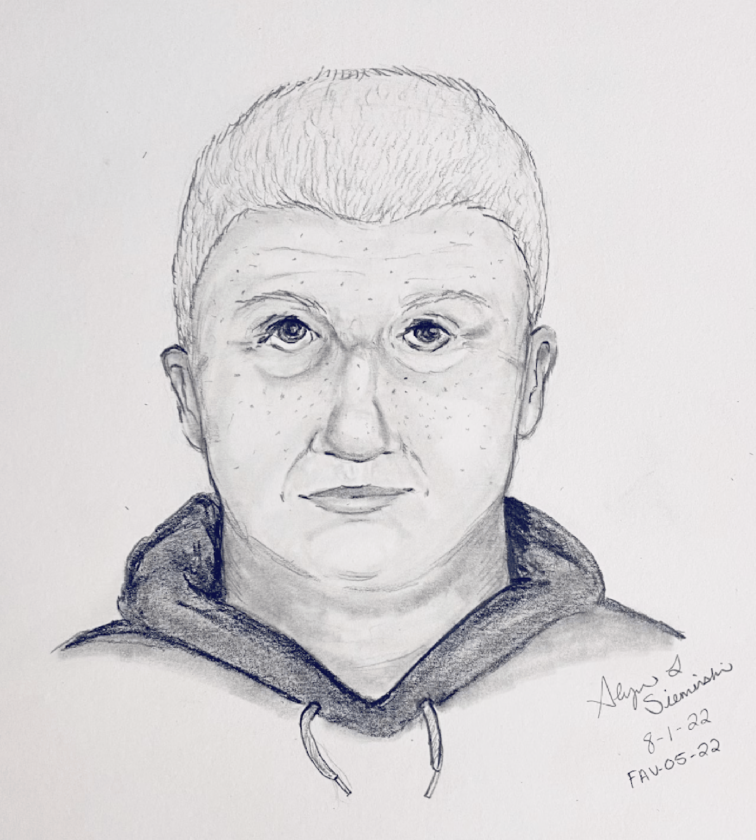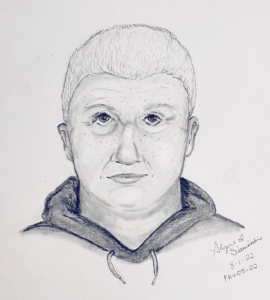Forensic artist says AI can’t replace much of what she does

A sketch by Michigan State Police Trooper Alyson Sieminski of a homicide and assault suspect from the Upper Peninsula. (Michigan State Police)
LANSING – As new technologies emerge, surveillance and cameras remain the State Police Forensic Art Unit’s biggest “competitor,” and one artist says the use of artificial intelligence for forensic art might create public mistrust by trying to be pleasing to the eye instead of following the evidence.
“AI stuff is meant to be more aesthetically pleasing – it’s not meant to be accurate,” said Alyson Sieminski, a state trooper assigned to the Gladstone Post in the Upper Peninsula.
Sieminski is one of the six forensic artists in the department’s Forensic Art Unit.
“I don’t think anybody’s ever going to be able to replace actual people drawing this stuff, especially when you’re dealing with a composite sketch,” she said.
The unit produces different types of sketches, such as composite, age-progression and postmortem sketches.
Composite sketches use a witness who recalls details of a suspect’s face for the artist. Age progression sketches start with a photo of the subject at a younger age. Postmortem sketches create a life-like image after death.
“When we’re doing a composite sketch, the purpose isn’t to be aesthetically pleasing. It’s to get information out that a victim or a witness has seen,” she said.
“If I’m doing a composite sketch off of an interview, I try to get a description from somebody in an interview. And while I’m drawing it, I’m constantly showing this person, ‘does this look like this person? What can I change to make this look more like what you remember?'” Sieminski said.
A composite sketch she made in 2022 helped solve a multi-state crime and killing rampage.
After a man assaulted a woman in Iron County in August 2022, Sieminski made the sketch based on the woman’s description of the man.
That sketch and a vehicle description were shared with the media, and within four to five hours investigators received 12 to 15 credible tips, according to an account by a State Police manager and published in the magazine of the Michigan Association of Chiefs of Police.
The suspect, a Caspian man, was identified and arrested in Alabama on charges related to the Upper Peninsula assault and murders in Wisconsin and Alabama, the account said. Caleb Anderson has since been sentenced to life in prison in both states for those deaths.
“With AI generative stuff, you have to keep feeding the AI images,” Sieminski said, “If your person isn’t in that image, you’re not going to get an accurate image out of it.”
She said AI technology may be viable in a few years for age progression sketches, “but you can’t replace the training and experience of somebody who has dealt with postmortem sketches and has had success with it.”
Sieminski said that age-progression sketches are made “when a missing person has been gone for, generally speaking, over 10 years, or if they’re like a child reported missing at 13 and could be 16 or 17 years old – we’ll do sketches like that.”
“A lot of times, it’s to try to get more interest in a case. A lot of times it’s cold cases, people that have possibly been trafficked or runaways.”
Sieminski said that for age-progression sketches, she starts by trying to get the most recent picture of the missing person’s face.
“Everybody looks like a pretty good mixture of both of their parents. We try to get pictures of them or siblings or whoever is still alive that can give us that information and see how they have aged.”
“We apply some of the aging factors that the family has had to what that person could look like.”
She said such cases require a little more creativity. “It’s definitely not an exact science.”
A postmortem sketch is made when skeletal remains have been found or when “John and Jane Does” – whose identities are unknown – have recently died but police can’t release a photograph of the corpse to the public.
“I’ve done sketches like this where I will draw somebody or (use) Photoshop to look like they’re living, to try to figure out who they are,” she said.
Her most recent postmortem sketch released to the public was done at the end of August in collaboration with the Wisconsin Department of Justice’s Division of Criminal Investigation in hopes the public could help identify a woman whose skeletal remains were found by a hunter in a rural wooded area in 2022.
“It’s still an active investigation,” she said.
“They ended up getting mitochondrial DNA back because it is very difficult, especially when there are only skeletal remains. I think they have to go through the jawbone to try to retrieve it.”
Sieminski drew her sketch based on the forensic lab results, which showed that the victim had Central or South American ancestry.
Sieminski said that forensic artists’ “biggest competitor is that most places are heavily surveilled now.”
“You’re on a camera, especially in a city. There’s so much security footage, doorbell cameras, traffic cameras. If you get a good, clear shot of somebody’s face, you don’t necessarily need a sketch like in the past,” she said.
———
This story was provided by Capital News Service at Michigan State University.




